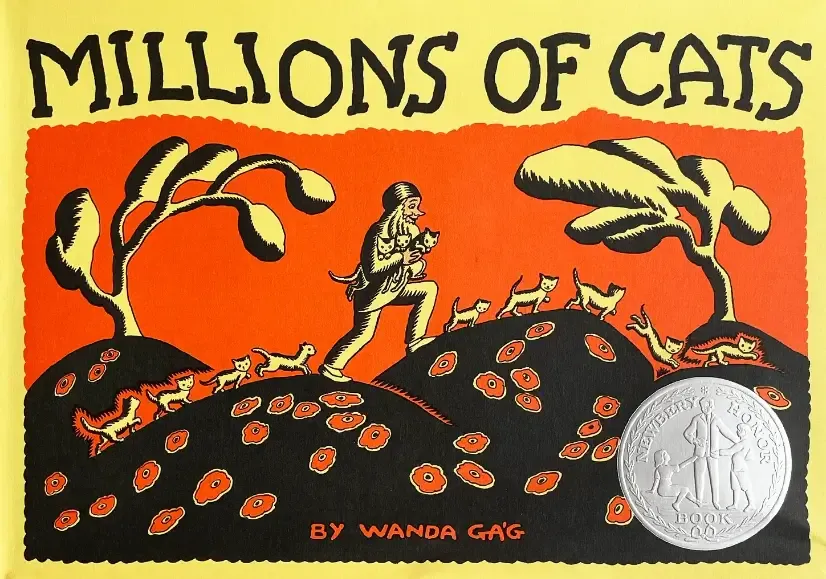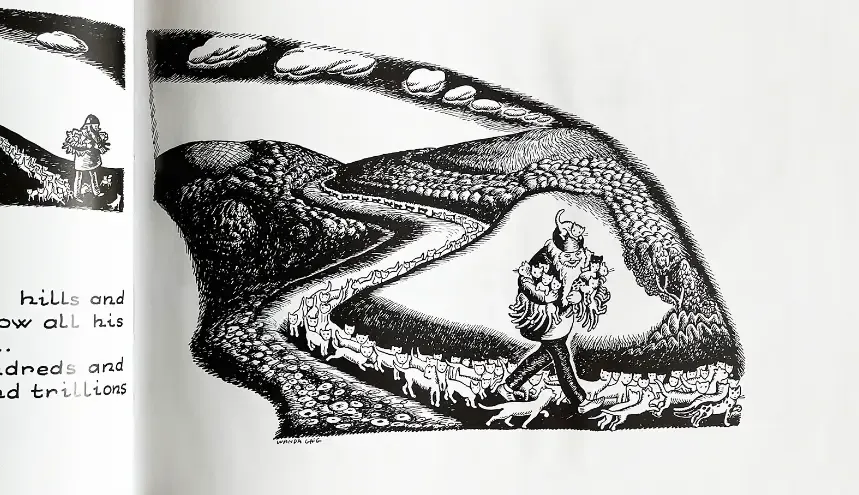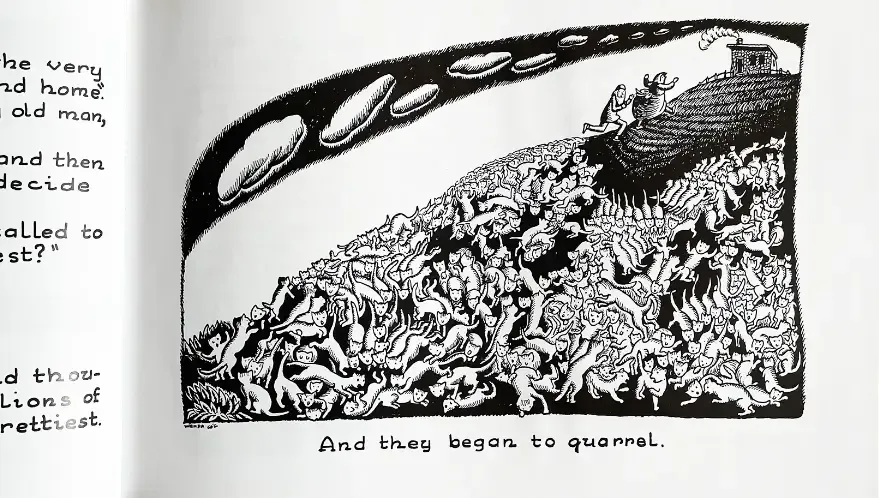Wanda Gág’s Millions of Cats is a beloved classic that has stood the test of time since its publication in 1928. This enchanting and slightly quirky tale of an old man’s quest to find the perfect cat for his wife is both simple and profound. Through its rhythmic, repetitive text and black-and-white illustrations, the book weaves a timeless story about the consequences of excess, the value of simplicity, and the unexpected way love can grow.
The story begins with a lonely old man and woman who wish for a cat to keep them company. The old man sets off on a journey to find the perfect feline and stumbles upon a hillside teeming with “hundreds of cats, thousands of cats, millions and billions and trillions of cats.” Faced with such an overwhelming number of beautiful cats, the old man cannot choose just one. So, in a somewhat whimsical and absurd twist, he decides to take them all home. As the old man leads this enormous herd of cats back to his wife, the once simple task of picking a single pet spirals into an amusing and thought-provoking dilemma.
Gág’s use of repetition is one of the most effective elements of the book. Phrases like “hundreds of cats, thousands of cats” are repeated throughout, creating a lyrical, almost musical quality that makes the story easy for young readers to follow and recite. This rhythmic pattern not only engages children but also gives the book a folk-tale-like feel, making it a perfect choice for read-aloud sessions. The repetition also mirrors the overwhelming abundance of the cats, building tension as readers wonder how the old couple will manage to deal with so many.
The illustrations in Millions of Cats are simple yet incredibly detailed, drawn in Gág’s signature pen-and-ink style. The monochromatic palette allows the richness of texture and expression to shine through. Every page is filled with swirls and flowing lines, capturing the vastness of the cat-filled hills and the gentle, humble nature of the old man and woman. The cats themselves are drawn in various poses and sizes, giving each one a unique personality despite their sheer numbers. Gág’s artwork manages to be both whimsical and expressive, grounding the fantasy of millions of cats in a setting that feels tangible and real.
At the heart of the story is a lesson about greed and the perils of wanting too much. When the cats finally arrive at the old couple’s home, they begin to argue over who is the prettiest and most deserving of being chosen as the family pet. This argument quickly turns into a vicious fight, with the cats devouring one another in their vanity and competitiveness. In the end, only one small, humble, and seemingly unremarkable kitten remains, too shy to have participated in the fight. This kitten is ultimately chosen by the old couple, who appreciate its quiet and unassuming nature.
The story’s resolution carries a deeper message about the beauty of humility and the importance of inner qualities over outward appearances. The old couple, who simply wanted one loving companion, find that the smallest and most unassuming of the cats is the one that brings them the happiness they sought. Gág subtly teaches children that it’s not always the biggest, loudest, or most outwardly beautiful things in life that matter, but the quiet, kind ones that make the most difference.
Millions of Cats also touches on themes of abundance and the natural consequences of overindulgence. The old man’s inability to choose just one cat from the countless options reflects a common human desire to have more, even when more isn’t necessary or sustainable. The chaotic fight among the cats serves as a metaphor for how too much of something, especially when driven by vanity or selfishness, can lead to destruction. In the end, simplicity and contentment prevail, a lesson that resonates just as strongly today as it did nearly a century ago.
Though the story has dark undertones, such as the cats’ self-destruction, it is handled with a light touch that keeps the tone appropriate for young readers. The humor and absurdity of the situation balance out the more serious themes, making the story accessible without feeling heavy-handed. Children can enjoy the fantastical element of millions of cats while absorbing the story’s deeper moral lessons almost without realizing it.
Millions of Cats is a timeless classic, blending whimsical storytelling with meaningful lessons about greed, humility, and the value of simplicity. Wanda Gág’s gentle prose and intricate illustrations create a story that is both visually and narratively rich, inviting readers into a world where millions of cats can exist, but only one quiet, kind kitten is truly needed. It’s a story that leaves a lasting impression, one that children and adults alike will remember long after the final page is turned.
Questions to ask while reading:
- Why do you think the old man wanted to bring home a cat?
- What lesson do you think the story is trying to teach about having too much of something?
- How does the story show that sometimes the simplest choice can be the best one?




